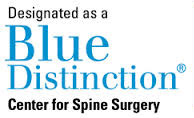Spine Anatomy Part 2 – Cervical Anatomy
In the second part of our series on the anatomy of the spine we’ll look at the cervical anatomy.
In part 1 we talked about vertebrae anatomy. Now that we have a basic understanding of the anatomy of each individual vertebrae we can start to take a look at how groups of vertebrae work together to form different sections of our spine.

Spine Anatomy Series
- Vertebrae Anatomy
- Cervical Region
- Thoracic Region
- Lumbar Region
- Sacrum and Coccyx
- The Spine as a Whole
In Anatomy, What Does Cervical Mean?
The word cervical can be broken down into two parts:
- Cervix: The root of the word comes from the Latin word cervix which means the neck.
- -al: The suffix -al means of or pertaining to.
When the two parts are put together they make the word cervical which means ‘about or pertaining to the neck’.
However, the term cervical can have two different meanings as it relates to anatomy1:
- Of or pertaining to any neck
- Of or pertaining to the female cervix (ie: the neck of the uterus)
In this article we’ll take a closer look at the cervical anatomy as it relates to the human neck, the first meaning.
What is the Cervical Area of the Spine
Now that we understand where the word cervical comes from it’s easy to see that the cervical area of the spine describes the portion of the spine located within our neck.
Cervical Vertebrae Function
Last week we reviewed the anatomy of each vertebrae. Within the human neck, 7 of these vertebrae work together to provide structure, aid movement and protect the spinal cord, the cervical vertebrae main functions.
What Are the 7 Cervical Vertebrae
The vertebrae of the spine are often referred to by a letter and a number. The letter signifies the section of the spine (C for cervical). The vertebrae are then numbered from top to bottom. So, the seven cervical vertebrae are called: C1, C2, C3, C4, C5, C6 and C7.
C1 (The Atlas)
The topmost vertebra, C1, is called the atlas. The C1 vertebra differs slightly than typical vertebra in that it has no body. This is because it is fused to the C2 vertebra. The C1 and C2 vertebrae, together, form the joint with the base of the skull.
C2 (The Axis)
The second vertebra, C2, is called the axis. This vertebra forms the base on which C1 (atlas) can rotate.
C3, C4, C5 and C6
The next four vertebrae going down the spine are C3, C4, C5 and C6.
C7 (Vertebral Prominens)
The seventh vertebra is called C7 or the vertebra prominens. The name comes from the prominent projection that protrudes toward the back of the body. This projection can be easily felt on the outside of the body.
Cervical Anatomy
The seven cervical vertebrae are the smallest of the vertebrae and are slightly different than the rest of the vertebrae in the spine as they have hole (called foramen) in each of their transverse processes.
Note: Remember from vertebrae anatomy that the transverse processes are the two spiked sections that protrude at an angle out each side of the vertebrae, toward the individual’s back.
The vetebral artery, vein and nerves pass through these holes in the transverse processes.
Cervical Nerves
A nerve branches out from the spinal cord above and below each cervical vertebra. These cervical nerves are numbered for the vertebra below them (except for the nerve below C7, which is labeled C8). For example, the C3 nerve is located between the C2 and C3 vertebra.
These cervical nerves carry motion and sensory information to and from the brain to different parts of the body. As a result, if a cervical nerve is injured it can have an significant impact on the motor skills and senses in another area of the body.
Stay tuned on our blog and facebook page for the next part in our spine anatomy series.
References
